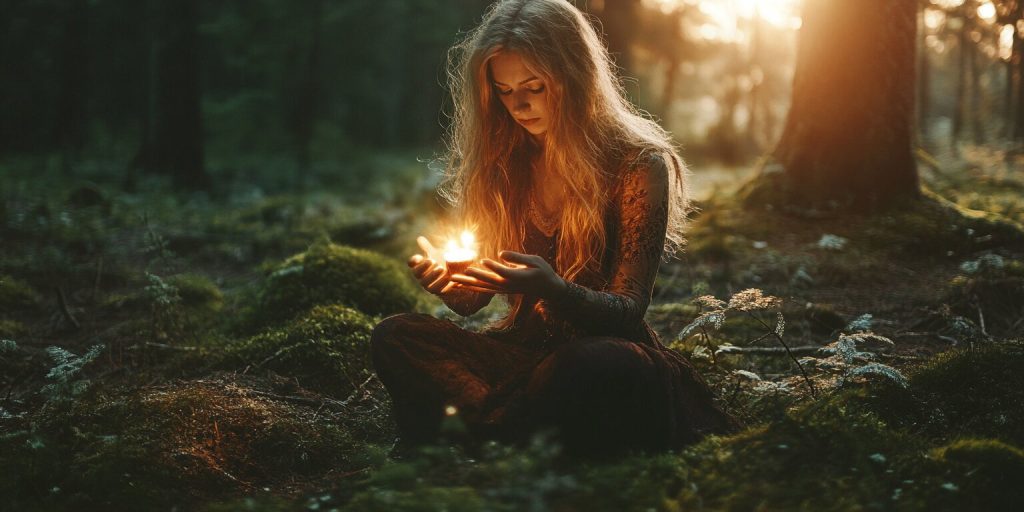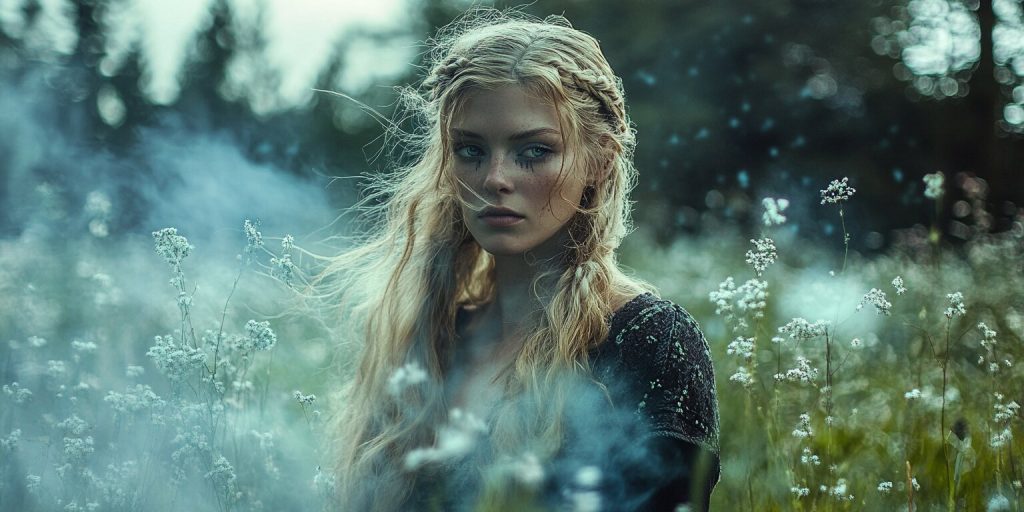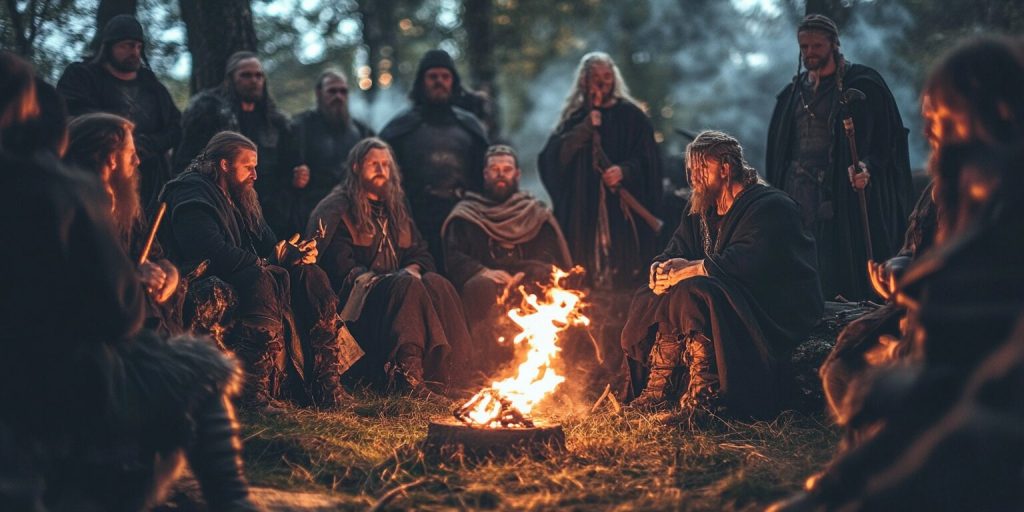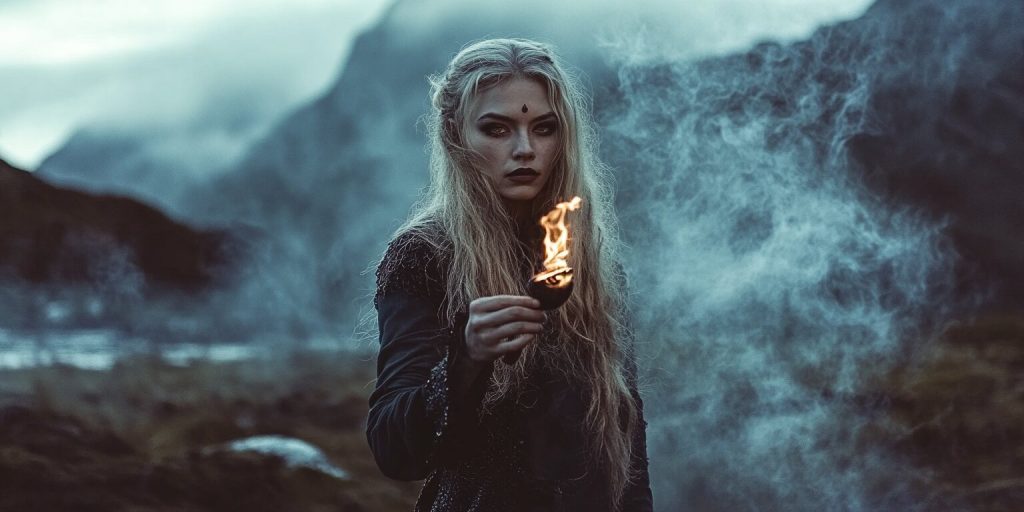Aesir Gods, Freya, Norse Goddesses, Norse Gods, Norse Mythology, Odin, The Norns, Vanir Goddesses, Vikings
What Is A Viking Witch Called?
The idea of a Norse Viking witch is a big part of ancient Scandinavia’s culture. The völva, a witch who practices seiðr, is at the heart of this. These witches were known for seeing the future and changing fate.
They were very important in Viking society, especially in places like Iceland. Knowing about the völva helps us understand Norse witchcraft better. It also shows how these witches affected the Viking Age.
Norse Witchcraft: An Overview
Norse witchcraft is deeply connected to the Vikings’ pre-Christian traditions. It mixed magic and spirituality, becoming a key part of Old Norse culture. At its heart are pagan rituals, which were practical and spiritual for those who practiced them.
The Origins of Witchcraft in Norse Culture
Norse witchcraft’s roots go back to Viking society’s early days. Early witches used folk medicine and healing skills, mixing religion with practical knowledge. Their rituals were crucial, covering health, fertility, and navigation.
The connection to nature was strong. Many rituals and beliefs were linked to seasons and farming.
Common Practices and Beliefs
In Norse witchcraft, common practices showed its importance in Viking life. Seiðr, a magic type mainly done by women, included spells and rituals. These rites often involved:
- Divination and prophecy
- Healing spells with herbs and charms
- Ritual offerings to gods and spirits
Beliefs around these practices stressed harmony between the spiritual and physical worlds, reflecting the ideals upheld by the fyrkat. The community was vital, showing how witchcraft brought people together. It helped meet collective needs and concerns.
The Term for a Viking Witch
The word “völva” tells us much about female magic users in Norse society. It’s not just a title; being a völva as a Nordic witch name carried significant weight in Norse culture. It’s a respected role filled with tradition and importance in Norse mythology.
Understanding the Word “Völva”
The Norse word for witch, “Völva,” comes from Old Norse and means “wand-wielder.” This name reflects the magical side of this role. A völva was often a seeress, able to see the future and perform magic.
This word is more than a witch. It’s about someone connected to the spiritual and mystical worlds. They practiced seiðr, a mix of divination and trance.
Comparison with Other Terms in Norse Myth
In Norse mythology, völva and seeress are different. Both see the future, but völvas had special rituals. This shows how Norse culture, including the beliefs of the Vanir, saw gender and the divine.
Sagas tell us how these roles changed. They show the deep magic and spirituality in Viking society.
Norse Viking Witch and Seiðr Magic
You are in the right place if you have ever wondered about the seiðr meaning. Seiðr magic was very important in Viking society. It helped people connect with their hopes and their community. Those who practiced seiðr, like famous völvas, could see the future and shape it.

The Role of Seiðr in Viking Society
In Viking society, seiðr magic was more than just a secret art. It was key to the community’s life. People respected and sometimes feared those who could do seiðr. It helped them deal with hard times like war and bad harvests.
Being good at seiðr made someone important. They could lead and guide others.
Rituals Associated with Seiðr Magic
The rituals of seiðr magic were full of symbols and old traditions. Practitioners went into a trance to get messages from beyond. Their rituals used special tools and ways to connect with the unknown, such as henbane.
- They called on gods like Odin and Freyja for guidance.
- A staff or seiðr pole helped channel spiritual power.
- They made a special place for rituals, often with music or chants, reflecting the practices of the Vanir.
These rituals showed how seiðr magic changed lives and society. They showed a deep bond between the spiritual and the real world.
Seidr Norse Mythology
The connection between Norse mythology and witchcraft is deep. Gods like Odin and Freyja are key to understanding magic. Their stories show a mix of respect, fear, and wonder for witchcraft.
Involvement of Gods like Odin and Freyja
Odin, the Allfather, is wise and skilled in magic. He sought knowledge, even at a high cost. This shows how important magic was to him.
Freyja, the goddess of love and fertility, is also linked to magic. Her practice of seiðr, sorcery, shows how gender and magic were connected in Norse culture, particularly among the Vanir. These gods represent the potent mix of order and chaos in witchcraft.
Witchcraft in Viking Sagas
The Viking sagas examine witchcraft’s role in society. They portray witches as wise and powerful figures. These stories often link witches to Odin and Freyja, indicating divine approval of their practices.
The sagas are set in the rich world of Norse mythology. They show a complex world where knowledge, power, and social norms are intertwined.
Role of Women in Viking Society
Norse women were vital in Viking society, especially in seiðr. This ancient magic showed their deep understanding of the pagan religion. It also gave them a special authority, challenging old gender roles.
Women as Practitioners of Seiðr
In Viking culture, women did seiðr, known as völvas or seeresses. They were vital for divination and magic, helping everyone, much like the norns who weave fate. They held rituals that could change fate, heal, and talk to spirits.
This showed respect for Norse women. They were not just followers but leaders in their societies.

High Status of Norse Witch in Society
Women who did seiðr had a high status. They guided their communities through tough times, and their skills went beyond home, making them advisors and leaders.
This shows Norse women’s power and respect. Seiðr was a big part of Viking life, making their roles even more important.
Archaeological Finds and Viking Witchcraft
Viking Age graves have provided us with much information on witchcraft. We’ve found many artifacts that show how völva, the Norse witches, lived and worked. These finds tell us about their magical skills and roles in society.
Evidence from Viking Age Graves
Graves from the Viking Age have many items that help us understand völva practices. Some key things we’ve found include:
- Ritual tools like staffs and bowls with special carvings.
- Offerings like bones, herbs, and stones for magic.
- Personal items show the high status of those buried with these items.
These items show us the spiritual and practical sides of witchcraft back then. They highlight how important these roles were in Viking society.
Discoveries Relating to Völva Practices
Archaeology has also uncovered details about völva practices. Some important discoveries are:
- Amulets and charms to boost magical powers.
- Signs of ceremonial spaces in graves show ritual gatherings.
- Images and writings that show völva’s many roles in Norse culture.
These findings confirm what we know about völva practices. They show how magic was part of Viking life. These discoveries help us connect today’s knowledge with the ancient traditions of Viking witchcraft.
Rituals and Tools Used by Viking Witches
Viking witches had a strong bond with the spiritual world. They used many ritual tools and amulets for magic. These items helped them do seiðr and were important in their culture. Knowing about these tools shows how magic was practiced in Viking society.
Common Tools and Amulets
Some common tools were:
- Wands: Made from nature, these wands helped channel energy in rituals.
- Amulets: These charms kept bad vibes away and brought good ones.
- Herbs and Roots: Certain plants were used for their magical powers and meanings.
- Runestones: With symbols, they helped talk to the spiritual world and predict the future.
Ritual Practices and Their Significance
Viking witches had many rituals that were full of meaning. Some key parts were:
- Invocation of Deities: Magic started with asking gods and goddesses for help and power.
- Seasonal Celebrations: Rituals were tied to nature’s cycles, celebrating important times like the moon and sun, which are central to Icelandic traditions.
- Community Involvement: Many rituals bring people together, making them feel united.
The tools and rituals showed Viking witches’ deep spiritual beliefs, particularly through their connection to the norns. They shaped their place in society as a völva would in Nordic traditions.
The Influence of Witchcraft on Viking Culture
Witchcraft was key in Viking life. It mixed with daily tasks, showing a rich mix of beliefs. People saw magic as part of their lives, affecting farming and healing.

Magic in Viking Daily Life
Vikings lived with magic all around them. It shaped their choices and how they interacted. They used:
- Amulets for protection and luck.
- Rituals for good harvests.
- Witch guidance for personal or community problems.
This shows how witchcraft kept Viking communities safe and connected, echoing the roles of the Norns in shaping destiny.
Folklore and the Preservation of Witch Traditions
Folklore helped keep witch traditions alive. Stories of witches and magic spread through stories. This helped communities:
- Keep their culture strong through changes.
- Learn from supernatural encounters.
- Feel connected through shared stories.
These stories kept Viking history alive. They also let people today connect with Viking culture and its magic. Folklore and witch traditions still influence how we see Viking life today.
Seiðr and Shamanism in the Viking World
In the Viking world, seiðr mixed mystical practices with shamanism. This mix helps us understand the spiritual world of seiðr. It shows how entering trance states leads to prophetic insights.
Parallels Between Shamanism and Viking Witchcraft
Shamanism and Viking witchcraft share key practices. Both aim to reach the spiritual realm, like the Norse völva, who practiced magic. Seiðr practitioners, like shamans, use rituals to go beyond normal thinking.
They act as bridges between the physical and spiritual worlds. They seek guidance and knowledge beyond everyday life. Some common practices include:
- Ritual drumming to induce trance states
- Use of sacred herbs or substances
- Connection with animal spirits or guides
Trance States and Prophecy
Trance states are key for seiðr practitioners. They allow access to visions or prophecies, which can reveal deep truths about the past, present, or future.
Prophetic experiences often happen during these states. They let practitioners, such as medieval witches, share messages from the divine. The link between trance states and prophecy shows the importance of altered consciousness. It connects Viking traditions to shamanistic practices worldwide, similar to those in Icelandic culture.
Conclusion
The study of Norse viking witches shows a unique part of Viking culture. It mixes spirituality with everyday life. We examined witches’ origins, rituals, and roles in Norse myths. They were important, not just for magic but also in their communities.
Viking witches were more than just magic users. They were respected members of society. Their rituals connected them to the divine and gave them special knowledge.
Thinking about Norse witchcraft’s legacy, we see it still affects our views of Viking history and myths today. Learning about völva and its impact helps us see the rich culture of Vikings. It also shapes our stories about magic and beliefs today.

